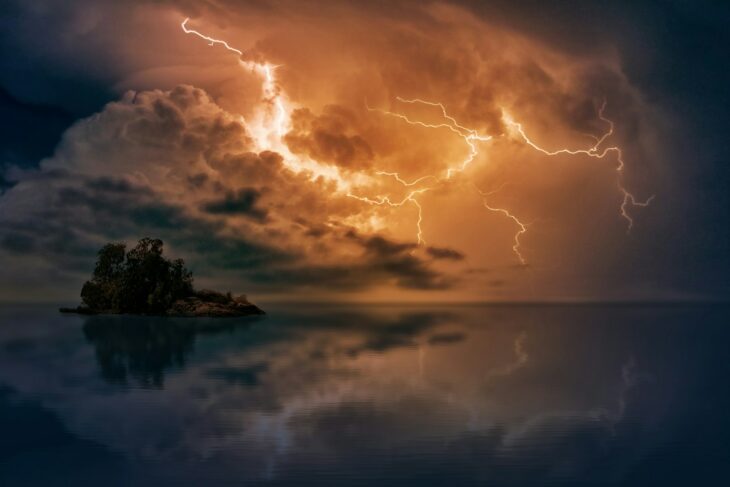Nitrogen is a vital element for life and an integral part of our DNA and proteins. Much of the nitrogen on Earth exists as gaseous nitrogen in the atmosphere, denoted N2, which most organisms cannot directly use. In modern ecosystems, some microbes have specialized enzymes to convert N2 gas into a form that they and other organisms can use, called fixed nitrogen. These microbes are called nitrogen fixers.
However, 3 to 4 billion years ago in an eon of Earth’s history called the Archean, life had not yet evolved, so nitrogen fixers did not exist. Scientists who study the origin of life, therefore, face a classic chicken-or-egg problem: life needed nitrogen to evolve, but before life evolved, there were no microbes to convert N2 gas into a usable form! So, where did life get its nitrogen before nitrogen fixers existed?
Researchers recently hypothesized that life on early Earth could have gotten fixed nitrogen from lightning. They proposed that the high energy of a lightning spark could react with oxygen and N2 in the atmosphere to fix N2 gas into other usable forms of nitrogen, called nitrogen oxides.
Geologists have studied the sedimentary rock record to understand nitrogen throughout Earth’s history, but they didn’t have a way to distinguish lightning-sourced nitrogen in rocks from other ancient nitrogen sources. To test whether lightning provided fixed nitrogen to early life, researchers led by Dr. Patrick Barth created “lightning” in a bottle to see if it reacted with N2 gas and produced nitrogen oxides with an identifiable signal.
To simulate lightning, the researchers used electrodes in glass flasks containing different gas mixtures. To mimic modern Earth, Barth and colleagues used a flask with a composition like our current atmosphere, containing 85% N2 and 14% oxygen. They also used flasks that contained an atmosphere like Archean Earth’s, which scientists think was around 83% N2, 0% oxygen, and 16% carbon dioxide.
They put 50 milliliters, or about ¼ cup, of water in the bottom of each flask so the nitrogen oxides and other compounds formed during the reaction would dissolve into it. They sparked each experimental flask for 15 to 60 minutes with a voltage of about 50 kilovolts, which is nearly 10 times stronger than the voltage of an electric car battery.
The team used an instrument that separates and measures different forms of elements, called a quadrupole gas analyzer, to measure nitrogen compounds in the gas from each flask before and after they sparked it. They found that in the modern experiments, more fixed nitrogen was dissolved in the water than in the gas. However, in the Archean experiments the fixed nitrogen was split about evenly between the water and the gas.
After each reaction, the researchers also put the water from the flask into an instrument that weighed the nitrogen atoms in it, called a gas-source mass spectrometer. They explained that nitrogen atoms exist in 2 main forms with different masses, called isotopes – the 14N isotope is lighter and much more common in nature, while the 15N isotope is heavier and less common. The researchers used data from the mass spectrometer to calculate the ratio of nitrogen isotopes in their lightning-fixed nitrogen samples. They compared these nitrogen isotope ratios with nitrogen isotope ratios from 3.1 to 3.8 billion-year-old rocks to see if they matched.
The researchers discovered the nitrogen isotope ratios in nitrogen produced by lightning were lighter than the nitrogen isotope ratios in the rocks by about 0.1% to 1%. They suggested this difference in nitrogen isotopes indicated that most nitrogen in the Archean rocks was probably not created by lightning.
The researchers also used the lightning flash rate on modern Earth to predict the amount of nitrogen oxides lightning could produce per year. They estimated that the annual lightning rate alone could not have provided enough nitrogen to support early Earth ecosystems. They explained the Archean would have had even less lightning than the modern day, so would have supplied even less nitrogen for early life.
The researchers concluded that lightning was not the main source of usable nitrogen for early life. They suggested that nitrogen fixers must have evolved very early in Earth’s history, so life didn’t have to rely on lightning alone. However, the researchers suspected that small amounts of fixed nitrogen from lightning could still have aided early life, because one rock sample from 3.7 billion years ago had a nitrogen isotope ratio similar to lightning-fixed nitrogen. They further suggested the lightning-fixed nitrogen isotope ratios from this study could be used to investigate how nitrogen is fixed on other planets in our solar system.


